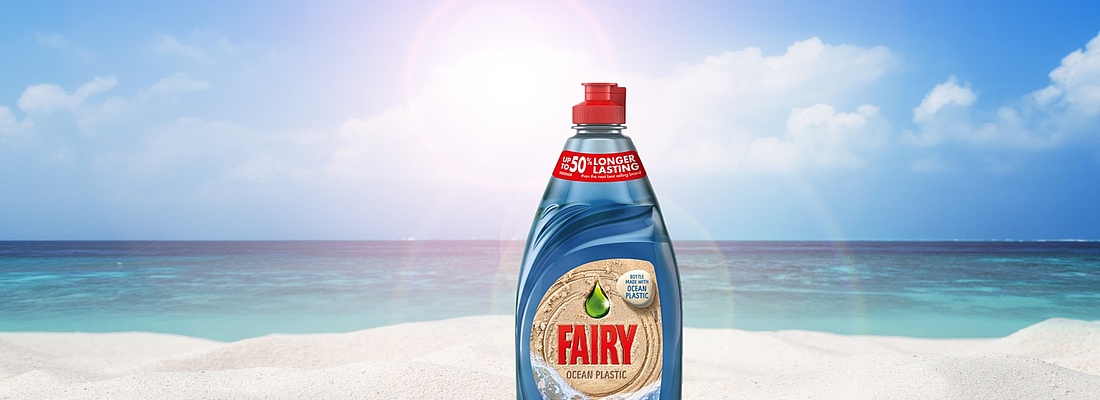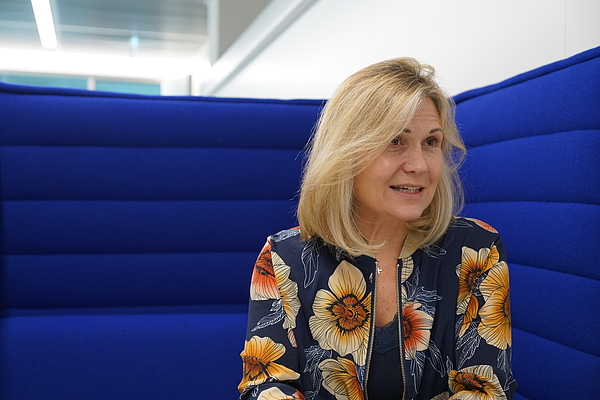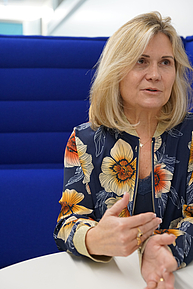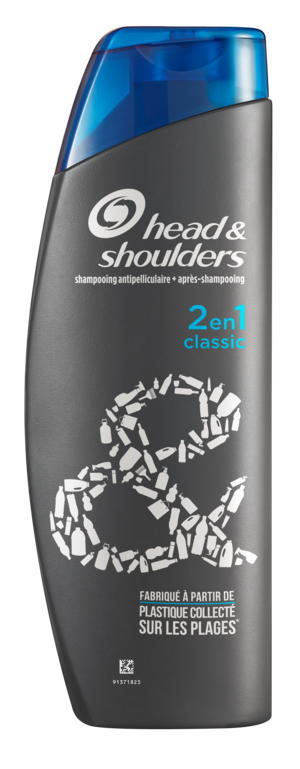

Photo credit: P&G
Interview with Virginie Helias, VP of Global Sustainability at P&G
The Emotional Appeal Of Going Green

“I don’t want my legacy to be packaging in a landfill.”
Interview with Virginie Helias, Vice President of Global Sustainability at P&G
Please tell us about your background and why you arepersonally focusing on sustainability at P&G.
I spent 23 years working on brand building and innovation. When I was in charge of the Ariel brand for Europe, I launched the Ariel Cool Clean campaign which was one of the mostsuccessful Ariel campaigns and at the same time, as I learntlater, had the greatest positive impact on the environment.That was the starting point of understanding that our brandscan be a force for good and a force for growth at the sametime. The company agreed to create a job that would be abridge between sustainability and the business, embeddingsustainability in every business practice. And so I got the job.
How did you approach your new position as Vice Presidentof Global Sustainability, a very new topic for P&G?
I started with a totally blank slate. No one had any preconceivedexpectations, which is the best position to be in. So I askedmyself, “Where should I start?” After all, there is so much todo. I realised that when it came to sustainability, there wasa lack of understanding among company leaders, and so Istarted with one-on-one meetings with all of these leadersto help them appreciate how sustainability can be a businessand innovation driver.
What played a greater role in your decision to take responsibility for sustainability: emotions or facts and figures?
For me it was really about the opportunity to connect with something very personal, When people see their packaging on the beach, they get it. They ask themselves: what can I do so that it does not become my legacy? This is an issue that touches our hearts. Sometimes, people shared their family stories: “Actually, my daughter is doing a thesis on sustainability.” My kids were pushing me as well. I realised that I want to leave a legacy. And I don’t want my legacy to be packaging in a landfill. But before all, my decision was driven by what I mentioned earlier: understanding sustainability can create more value when done well. Value and values are both important.

How do you engage people internally?
I always start by understanding where a brand/business can make the greatest difference from a scientific perspective. We look at the Life Cycle Assessment and then we brainstorm ideas on how we can address these areas in a way that is relevant and authentic for the brand. That creates stories that make sustainability tangible for people and we are getting more stories …



Did the company claim leadership on the issue of sustainability right from the start?
We don’t like to claim sustainability – we prefer others to recognize it. In the area of sustainability, our approach has historically been doing vs talking - “actions speak louder than words”. We now recognize we need to talk about our accomplishments so that we can enrol others in helping us address the major societal challenges.
Can you describe the biggest obstacles in the beginning?
This had to do with changing the mindset. Our mindset had to change, and that took time. We had learnt to develop a successful business but sustainability was not part of it. So we needed to make the business case compelling. We started with people who were already convinced – a coalition of the willing – and we created quick wins that encouraged others to follow suit.
The consumer goods and packaging industry not only brings products but also packaging onto the market. Do you feel that this industry – and you, as P&G – shares responsibility for marine littering?
We are very clear in saying that we want to be part of the solution. Our sustainability work is not charity. There may come a time when we can no longer use plastics because they are banned. Addressing this issue is critical from a business standpoint.
Do P&G’s PCR and beach plastics initiatives also aim to prevent a ban on plastic packaging?
At P&G, we strongly oppose any ban because bans impede innovation. What if there is another material available that would be a better choice? One concrete example is the use of oxo-degradable plastics in Saudi Arabia. We neither want to ban plastic packaging nor do we want to insist upon it.
Instead, we want people to recognise that there is not one single solution. Moreover, we always want to encourage innovation. We avoid taking a prescriptive approach, which is an issue that we at P&G have with some of the eco labels. Their approaches are often too prescriptive, too limiting. Take lists of prohibited materials, for example. What if you figure out how to use these materials in a way that is better for the environment?
When it comes to packaging, there are two sides of the coin: product manufacturing and waste. For a long time the waste problem was ignored.
Plastics are great, but they need to be used in a way that is circular, i.e. they should be reused and recycled. One of the reasons that we are so invested in this topic is that plastic does not belong in the ocean. Once you, as a company, make your position known, then all sorts of people come to you with solutions. That’s why it is so important for major companies like P&G to announce that this is our intention. If you do that, start-ups and other organisations will approach you with their ideas and their proposals. This is how you can become a catalyst for change.

Let’s talk about Head & Shoulders, Lenor and Fairy: P&G is promoting the fact that it uses a high rate of recycled material in the packaging of these products. And when it comes to the Head & Shoulders Beach Plastic bottle and the Fairy Ocean Plastic bottle, there is a particular focus on the proportion of plastics recovered from the beach or the ocean. What is the driving force behind these projects?
The Fairy Ocean Plastic bottle is made of 100% PCR – a far greater percentage than the Head & Shoulders Beach Plastic bottle – and it contains 10% plastics from the ocean. The key message is that the bottle is made entirely of recycled materials. Therefore it is an invitation for people to recycle. The fact that Fairy is a very iconic brand, especially in the UK, is a major advantage. It sits on the kitchen counter and serves as a kind of daily prompt, reminding people of the ocean issue, as well as the role they can play by recycling. The bottle is both a message and an inspiration.
When people hear this ocean plastics message, don’t you worry that they will conclude that others – and in this case a leading company like P&G – are taking care of the issue? What if people feel that there’s no need to make an effort and they simply carry on as before?
The beach plastic bottle alone will not solve the problem of plastic pollution. The solution is recycling and using recycled materials. When we announce our beach plastic initiatives, our message is always twofold: We say that we are using beach plastic in limited quantities, but also that overall our shampoo bottles in Europe include 25% PCR. This is an important part of the solution. So the beach plastic bottle is ultimately a campaign to raise awareness. I’ve actually never thought of the campaign being misinterpreted in the way you suggest. Some people talk about “green washing”. The beach plastic bottle campaign could be called green washing if that were indeed all we were doing. But behind the scenes, we have the goal of doubling the amount of PCR used in our plastic packaging.
But isn’t that just a drop in the bucket?
Again, the beach plastic bottle alone is not the solution. But take a moment to consider the quantities of products that we sell. We are number one or number two in most of the categories where we have products on the market. If we use 25% PCR in our packaging – and the trend is rising – that’s not just a drop in the bucket. Not only that, but we are already working to expand this initiative to more brands and more countries. Here too, the principle is the same. Beach plastic only makes sense as part of a larger programme. Otherwise it’s just green washing. The Fairy Ocean Bottle will be the largest production run of its kind in the world, with 320,000 bottles produced for the UK alone. But as we’ve said, that isn’t enough. P&G can do more. Beach plastic is a tool to strengthen consumer awareness, but you also need to increase the scale.

What role do brands play? Can recycled packaging along with a clearly communicated packaging strategy help strengthen a brand?
Absolutely. The Head & Shoulders campaign makes this clear. Here at P&G, we have two types of people: those who are passionate about a project, who will participate in it no matter what, and those who want do the right thing, but are hesitant to lead and first want to see the business case. The latter are still in the majority. My strategy has always been to start with the passionate ones and then convince the others. This is also the approach I took to the beach plastic project. The Head & Shoulders global brand leader is very passionate. When she heard about the Ellen MacArthur Foundation’s prediction that unless we take action, there will be more plastics than fish in the ocean by 2050, she was really shocked by this. We brainstormed and decided that we had to do something. The result was the Head & Shoulders Beach Plastic bottle. Once this bottle had been introduced, many other brand leaders approached me saying that they wanted to do something similar. They didn’t ask for the business case; they didn’t ask for the cost. The brand idea was so irresistible that they wanted to have it. And that is precisely my point: It’s not about education; it’s about making it irresistible to do the right thing. It’s about inspiration.
Consumers are familiar with the white Head & Shoulders bottle. The Fairy bottle made of PET is clear. Did increasing the amount of PCR lead to changes in the colour concept?
Yes, and this leads right back to our previous discussion about education vs. inspiration. Consumers may not initially be interested in the fact that P&G has doubled the amount of PCR in its bottles. What grabs their attention is the fact that the Head & Shoulders bottle, which they know as a white bottle, is now grey. So they ask themselves why the bottle is grey, and that is how we draw them into the story. We have redesigned the packaging to include a number of little icons that tell the story and how they can contribute.

In your opinion, what are the main hurdles and barriers to becoming more sustainable as a company and using more sustainable packaging in particular?
see three main hurdles. The first is that it’s just very complicated. Very often, it is about tradeoffs. When you make changes on one vector, there can be repercussions in another. So managing all of these different aspects is very complex. The second hurdle is financial. There is often an initial on cost or payback times that are longer than what companies are used to - although it can also lead to cost saving like the work we are doing in our plants on energy, waster and waste reductions). And the final hurdle is that commercialising sustainable products in a way that is authentic to the brand is not easy.
You have certainly had interesting experiences with this over the years.
Definitely. It takes courage to lean forward. One of our leaders used to say that if he waited until sustainability is affordable, he would be waiting a long time. Once again, this is a case where passion can be the initial motivator – but ultimately it needs to work for the business. As we have seen so many times, when work is done on sustainability, good things happen. Take our approach to waste management in factories, for example. We have an organisation called GARP, which stands for Global Asset Recovery Purchases. This organisation is tasked with ensuring that nothing goes from the factory to the landfill. This means that waste is either recycled at the plant or we work with partners to repurpose products that do not meet our quality standards. For instance, off-spec detergents can be used in products for car washes. Currently 72% of our plants send zero waste to landfill on-track to our 100% goal by 2020. Since starting this programme, we’ve also saved 1.9 billion USD. When we launched the programme, we had no idea that this would be the case. We just knew that we would be saving materials. Then once things were underway, it resulted in big savings. So striving to achieve zero waste turned out to be the right thing to do from both an environmental and a business perspective.
A new trend seems to be creating partnerships.
Yes, partnerships occur on different levels. At P&G, one important partnership is with consumers. As a major company in the consumer goods industry, we partner with consumers all the time. We ask them what their needs are and what we can do to meet these needs. The number of discussions we have with the people who use our products is unmatched. We even have Innovation Houses in place in several parts of the world. These are incubators where we can bring people to use our products. This allows us to talk to consumers before, during and after their experience with our products, which provides us with very comprehensive information. Our goal is to work with consumers to take our solutions to the next level. Partnering with consumers also means taking advantage of their many innovative ideas. When we started the beach plastic campaign, we were overwhelmed by the number of suggestions. People are really interested and they want to help. Of course, consumers aren’t the only ones with innovative ideas. Start-ups also offer great new approaches and bring a special entrepreneurial spirit to the table.
What about partnerships with retailers?
Retailers are another important partner. We launched the Head & Shoulders Beach Plastic bottle with Carrefour in France, REWE in Germany and Super-Pharma in Israel. The Fairy Ocean Plastic bottle will be available at Tesco in the UK. We are joining forces with retailers, and retailers are very much behind us, offering us more visibility and merchandising for these products. This is a partnership that benefits both parties. Selling our products is great for the retailers’ reputations and helps them deliver what the customer wants. At the same time, retailers are pushing our message. Their merchandising educates shoppers and influences their behaviour, which in turn is helpful for the brand. So in the end, it’s a great deal for everyone involved.
Working efficiently with recycling material requires deep and specialised knowledge.
I’m glad you mentioned this. We also have excellent partnerships in this area. TerraCycle collected and sorted the plastic waste at European beaches, while SUEZ was responsible for the recycling process and ensuring the quality of the recycled material. Our scientists developed the design of the bottles. The results are high-quality bottles that meet the requirements of stability and safety.
Let’s talk about the future. Will there be less plastic in the oceans in five or ten years?
I certainly hope so, otherwise our efforts will have failed. I am a very optimistic person – you have to be optimistic to take on a job like this. I am convinced that there are advances in technology on the horizon that have the potential to revolutionise plastics recycling. This is a huge field of work, and many companies, associations and institutes are already involved. In August 2017, P&G presented its new technology for recycling polypropylene. Our scientists have figured out a way to restore recycled polypropylene plastics to “virgin-like” quality. But we are not keeping this technology to ourselves - we have granted licenses for our technology to PureCycle Technologies. P&G is also leading a work group as part of the new circular economy programme initiated by the Ellen MacArthur Foundation. Known as the “holy grail”, this work group has been tasked with creating harmonised standards on water mark and tracer technology. This is a huge area of research, and unless the same standards are applied across the industry, it will be a mess. We are also partnering with the Ocean Conservancy’s Trash Free Seas Alliance, whose objective is to cut the amount of plastic that makes its way into the ocean each year in half by 2025. We are a very active member of this alliance.
What are your goals for developing regions?
In developing regions, it’s about improving waste management infrastructure. In the Philippines, for example, we have had projects in place since 2010 that provide municipalities with resources and technology for waste management. We signed contracts with four municipalities this year, and we will break ground in early 2018. We think this is great, and we are very proud of these efforts. On the other hand, you could argue that only reaching four cities in seven years is not enough. The point is that we understand that this is important, and we are pushing partnerships that will allow us to quickly scale up this project. Progress is being and will continue to be made.
So in terms of waste, I am very hopeful that we will find solutions to reduce it. The other big issue is water. It’s not your focus, but it’s arguably even more important. Here too, a circular economy is part of the answer.
What is new or different about the way we understand the term “circular economy” today?
“Sustainability” is one example, and now the concept of the “circular economy” is having a moment. I think the circular economy is a good vision and the only way to continue to thrive with the limited resources we have. Did you know that P&G was actually founded on basis of the circular economy? P&G got its start in Cincinnati as a candle- and soap-making company. Cincinnati was a hub for the pork business, which means the city was home to a thriving meat packing industry. Two of the by-products of this industry are fat and oil, which P&G turned into candles and soap. This is a perfect example of the circular economy – zero waste! Today’s circular economy is more systemic, more holistic. That’s the difference. It doesn’t come about by accident, like the decision to use fat and oil from the meat packing industry to make candles and soap. When it comes to the circular economy, Europe is a clear leader. Although it’s starting to become a global trend, it has its origins in Europe with the Ellen MacArthur Foundation and the EU.
Speaking of the circular economy, let’s circle back to your story. When you started working on this issue, did you have any idea how important it would become?
When I got started, my main motivation was that I saw sustainability as a good move for the company. I didn’t anticipate that it would become THE hot topic of the future. As we did research on the macro trends that are expected to disrupt business, we saw that in terms of demographics, the most important groups are the aging population, the urban millennial and the Chinese middle class – we are already seeing the influence of these groups today. And in terms of innovation, the key trends are resource depletion, green chemistry and hyperconnectivity. Well, all of this is related to sustainability. When you talk about future scenarios, it all comes down to what is happening with resources, and, obviously, the social element in this. Social justice is linked to climate change, which is linked to water distribution. It’s all interconnected.
I understand P&G has been in the PCR business for 30 years now. What have you seen from your experience and what will you do differently going forward?
That is correct that we have been using PCR for 30 years and have been a leader in the plastics recycling industry. We also have specific 2020 packaging goals including reducing packaging by 20% per consumer use, doubling our use of recycled resin in plastic packaging and ensuring 90% of our packaging is recyclable or there are programs in place to develop the ability to recycle it. We continue to make excellent progress and going forward we want to use our innovative strength to bring new industry advances such as the PureCycle technology to enable a more circular economy.
Thank you for the interview.
The comPETence center provides your organisation with a dynamic, cost effective way to promote your products and services.

magazine
Find our premium articles, interviews, reports and more
in 3 issues in 2026.


